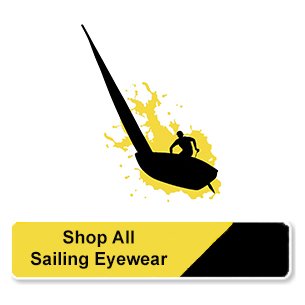
Sailing Top 10
What you need to Consider

Bright sun reflecting off the water and sails, fast tacks, spray from the waves, and weather that changes at a moment's notice. Sailors have to deal with these conditions when they are out on the water, and they require eye wear that can handle the challenge.
People who do water sports, above all other sports, are at a high risk for eye diseases such as cataracts and pterygium (a benign growth on the eye also known as surfer's eye). So as we all know prevention is the best cure. On the water you will experience you are more at risk of glare and UV. So getting the right lenses not only will help relax your eyes but also prevent you from getting eye injuries and other problems.
Below we have provided advice on selecting the best sunglasses for sailing and our recommended top 10 sunglasses ranges for 2021 based on their excellent performance and reliability. Typically lightweight and strong, with excellent optical qualities and performance coated lenses, the brands are trusted and worn by the Pros. Only the highest standards are good enough, and you should expect the best.
Key Frame Considerations for Sailing Sunglasses:

- Plastic Frame Materials - You should only choose plastic frames for sailing as metal frames can be dangerous as they could snap during a fall.
- Wrap around frame - 6 or 8 base curved frames (curved and highly curved lenses respectively) provides protection against the elements and a wide field of vision. Provides better ergonomic profile for firm fitting on face or head.
- Anti-slip nose pads - Help stop your sunglasses sliding down your nose when you are moving your head and provide maximum comfort.
- Anti-Slip Temples - Incorporates non slip components, helping to keep the frame securely on your face.
- Floating Head Band – To ensure if you drop your frames in the water you can still find them. If your choosen frame doesn't have a floatable head band you can get them separately CLICK HERE to buy.
- Lightweight- It's a good idea to have them as lightweight as possible this isn't necessary but just adds to your overall comfort.
- Removable Gasket - These are not necessary but we definitely recommend if you are planning on sailing for long periods of time or struggle with sensitivity from salt water/ wind in your eyes etc. This is a soft gasket held in place around the frame that avoids avoid snow, air or water penetrating behind the lens. A removable gasket is preferable as you are able to replace the gasket when it deteriorate due to sweat etc.
Key Lens Considerations for Sailing Sunglasses:

- Polycarbonate/ NXT - Only polycarbonate or the much stronger NXT lenses should be considered. Both glass and plastic lenses can shatter upon impact, which could cause lens particles to penetrate you eyes. Both polycarbonate and NXT lenses extremely impact resistance, light weight, durable and will not shatter upon impact. Both lens indexes are 100% UV protection.
- 100% UV protection - For protection from UV radiation.
- Anti-Reflective (AR) Lenses - Applied to the front or back surface of a lens, AR provides better visual acuity to judge distances, improves accuracy and eye comfort.
- Mirrored lens - Mirror coatings are good for situations that require a reduction in the overall brilliance of light, such as the sunlight on water. Note that back reflectance will be more noticeable with a mirror, especially on darker lenses. An AR coating on the back surface is strongly recommended.
- Polarised - Polarised lenses enable you to see possible obstructions under the surface of the water. They also reduce glare and eyestrain from reflections from the water’s surface. At the beach, even sand reflects sunlight. Polarised lenses reduce eyestrain from light reflecting off both the sand and the surf.
- Photo Polar Lenses -(photo polar lenses are both photochromic and polarising). If you live in a climate such as Great Britain where it can be cloudy one minute and sunny the next, then photochromic lenses that are polarised are worth considering. PhotoPolar lenses are activated by the amount of Ultra Violet (UV) light absorbed by the lens and get darker or lighter dependent on the weather ensuring that your vision through the lens is clear and bright at all times. The best PhotoPolar lenses for sailing will cover a range from Category 2 to Category 4 ensuring good light vision from cloudy to bright sunny days.
- Anti-Fog Coating – Eliminates condensation inside the lens. If this is not available for your choice of frame you can buy an anti-fog gel/ spray which will also help you. CLICK HERE to buy Anti-fog gel/ sprays.
Best Lens Colours to Consider for Sailing sunglasses:

- Grey/smoke - Grey lenses minimises colour distortion and are a good choice in the brightest sunlight. Grey is considered to be the best colour for water based activities.
- Brown - Brown is a good choice for all-purpose wear. Browns are also good for bright to intermediate conditions.
- Orange/Amber/Copper - These tints are ideal for variable light conditions as it increase contrast by highlighting colours and separating light from shadows. It will help define slight details in tonal colours on the water's surface even in flat light. I.E When breeze and wave heights create darker or light surfaces on the water.
- Yellow - Yellow is effective on dark overcast days. They help to improve contrast while providing protection from spray.
Prescription Considerations for Sailing Sunglasses:

- Polycarbonate / NXT - We always recommend you choose an impact resistant lens material for sports this will ensure your lenses are stronger then your usually glasses and can withstand the impact from a rocks and stick. Polycarbonate and NXT are both great options to choose. NXT is clearer, strong and has better clarity than polycarbonate but is not available for all sunglasses and high prescriptions.
- Polarised - Polarised lenses enable you to see possible obstructions under the surface of the water. They also reduce glare and eyestrain from reflections from the water’s surface. At the beach, even sand reflects sunlight. Polarised lenses reduce eyestrain from light reflecting off both the sand and the surf. If you suffer from glare it’s a good idea to use this in conjunction with mirrored lenses and an AR coating.
- Photo Polar Lenses -(photo polar lenses are both photochromic and polarising). If you live in a climate such as Great Britain where it can be cloudy one minute and sunny the next, then photochromic lenses that are polarised are worth considering. PhotoPolar lenses are activated by the amount of Ultra Violet (UV) light absorbed by the lens and get darker or lighter dependent on the weather ensuring that your vision through the lens is clear and bright at all times. The best PhotoPolar lenses for sailing will cover a range from Category 2 to Category 4 ensuring good light vision from cloudy to bright sunny days.
- Mirrored/ Flash Mirror lens - Mirror coatings are good for situations that require a reduction in the overall brilliance of light, such as the sunlight on water. A flash mirror coatings is the same as a full mirror but is predominately used for photochromic or photo/polar lenses. Unlike a full mirror a flash mirror will look like more of a sheen (or unnoticable) and will become full as your photochromic lenses become darker. You can get a flash mirror on non photochromic or photo/polar lenses if you want to help eliminate glare but don’t like the look of a full mirror (although please not the flash mirror is more prominent the dark the lens is). Note that back reflectance will be more noticeable with a mirror, especially on darker lenses. An AR coating on the back surface is strongly recommended.
- Crystal Vision Coating (our most recommend coating*) - This includes our FREE anti-scratch coating and includes hydrophobic (like the wax coating on your car this will ensure rain rolls off your lenses), anti-reflective (AR) (this is coated front and back and will help decrease glare and reflection off the lens and easy clean/ oleophobic (this helps eliminate dust and smudges on your lenses making them easy to clean and less likely to get dirty in the first place)
- Wrap sunglasses - Can select prescriptions that will fit directly into 6 base curved wrap frames or below only. For 8 base wrap frames, select one that will fit a clip-in prescription or a direct clip lens.
Tip: Anti-fog coating- This is not something we usually recommend. We only added the coating to our prescription range due to requests. Our main reason is that we do not think it off the bests value for money as our Crystal Vision as you can add an ant-fog gel but you cannot have any other coatings when you have a anti-fog coating. There are plenty of great anti-fog gels and sprays coatings CLICK HERE to choose.
(All products and brands are genuine and authentic. All prescription lenses are made in UK to EU rules and regulations and safety standards. We also check all frames and prescriptions before leaving our practice to ensure they meet your requirements.)
- Ordering Prescriptions
- Lens Options Explained
- About Glasses
- About Sunglasses
- About the Eyewear Brands
- Eyecare
- Eye Conditions
- Frequently Asked Questions
- Blog
- About Us
- Why Choose Eyekit for your Prescription?
- Varifocal Prescriptions
- Tint Colour Options for Prescription Lenses
- Special Offers
- Guide to Buying Eyewear Online at Eyekit
- Choosing Eyewear for Sport
Latest From Eyekit
Rain Rain Go Away- Why you need a Crystal Vision Coating on your Prescription Glasses and Sunglasses
The snow was short lived but us Brits know that the Winter/ Spring showers have just begun. You know how it starts, you get out your bike or you figure out your hike for the day on the map and
Eyekit’s Top 10 Tips to Help You Keep Your New Year’s Resolution
Every year we make them and every year we try and try but eventually break them. So its time to stop the cycle and (maybe take up...
Our top 5 Eyewear items to Help Your Eyes this Lock Down
We have looked at our top 5 most popular Eyewear items that people needed during the last lockdown that could help you with this...
Veganuary - Can Excluding Animal Products Have an Impact on Your Eyesight?
We often make connections between diet and cardiovascular disease or obesity but we often forget that eye sight and vision loss is also linked to...
Winter Is Here
Here's how you can help out your eyes this winter. THE SUN HAS GOT HIS HAT ON- even in winter You might only think you need your sunnies...









